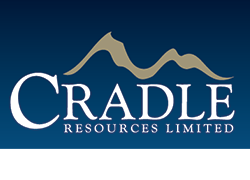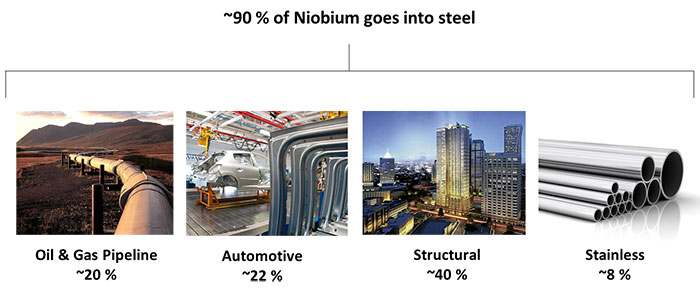About Niobium
Niobium (Nb) is a lustrous grey, ductile transition metal, with a high melting point and relatively low density; it also has super conducting properties. Previous to 1950 it was also called columbium (Cb).
Niobium is most commonly found in pyrochlore [(Na,Ca)2Nb2O6(OH,F)] and to a lesser extent Columbite [(Fe,Mn)Nb2O6].
Key Properties:
| Colour | grey |
| Melting Point | 2477º C (4491º F) |
| Density | 8.57 g/cm3 |
| Mohs hardness | 6 |
| Vickers hardness | 870-1320 MPa |
| Atomic Weight | 92.91 |
Producers
There are only three mines in the world that currently mine niobium as their primary product:
- Companhia Brasileira de Metalurgia e Mineração (CBMM): Araxá (Brazil)- produces approximately 84% of the world’s niobium
- China Molybdenum: Catalao (Brazil) – produces approximately 7 to 8% of the worlds niobium
- Magris Resources: Niobec (Canada) – produces approximately 7 to 8% of the worlds niobium
There have been no new niobium mines coming into production since the mid-1970’s.
Market and Pricing
Niobium is a boutique metal with one dominant producer (CBMM), the pricing is stable. Annual demand is between 90,000 and 100,000t FeNb per year. Publicly reported price data indicates that the Nb price (per Kg contained in FeNb) has averaged around US$41.50 for the last five years, with an annual price of over US$40 achieved in 2015.
Niobium is classified as a strategic metal by the USA with usage growth estimated to be 25% over the next 6 years. The current global market is approximately $3 billion p.a. (3 times the graphite market).
Ferro-niobium (FeNb) is the main niobium product with markets split predominantly between Europe, China, the Americas and Japan. The intensity of usage (FeNb in steel) is highest in the Americas (~110g/t steel), followed by Europe and Japan (~80g/t steel).
Significant growth potential is present in the current low usage in the Chinese market (~25g/t steel); China has no niobium deposits.
In 2011, the market leader CBMM sold a 30% stake in their operation; 15% to a Japanese / Korean group and another 15% to a Chinese group for an estimated US$1.5B each. The companies involved in this were predominantly iron and steel groups. .
In 2014 IamGold sold the Niobec mine to Magris Resources for US$530M.
In 2016 Anglo American sold the Catalao mine to China Molybdenum for US$1.5B.
Uses:
The majority of niobium (>80% world production) is used in the manufacture of high-strength, low alloy steel (HSLA). Niobium acts to refine the steel grains (micro-alloying) by forming niobium carbide and niobium nitride; these compounds improve the grain refining, retardation of recrystallization, and precipitation hardening of the steel. Added to steel, niobium will increase mechanical strength, toughness, high-temperature strength and also corrosive resistance. Microalloyed stainless steel has a niobium content of less than 0.1%.
Niobium steels are used on pipelines, transportation (cars) and structural applications (bridges and buildings). According to the World Steel Association, $9 of niobium used in car manufacturing will reduce the mass by 100kg, and introduce a 5% fuel efficiency; 300grams used in a mid-sized car reduces the weight by 200kg (CBMM). The addition of 0.02% (200g) Nb to a tonne of steel can increase its strength by up to 30%.
Niobium super-alloys (>20% Nb, e.g. NbTi, NbZr, NbTaZr and NbHfTi) are also used for high-temperature applications in jet engines, gas turbines, rocket subassemblies, turbocharger systems and combustion equipment. Thousands of kilograms of niobium were used in the advanced airframe systems of the Gemini space program.
Niobium alloys are also used to manufacture superconducting magnets for medical (e.g. MRI) and scientific applications (the Large Hadron Collider, gravity wave detectors). Niobium is hypoallergenic and is also used for medical implants and jewellery.


